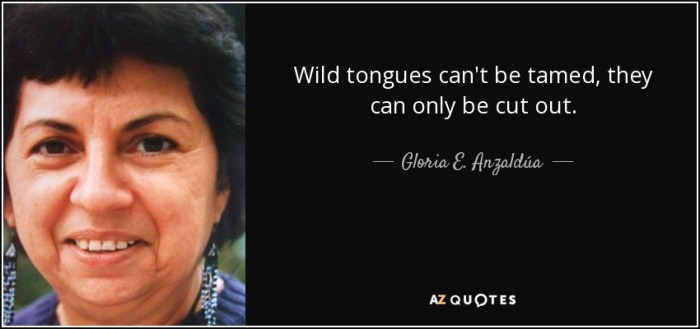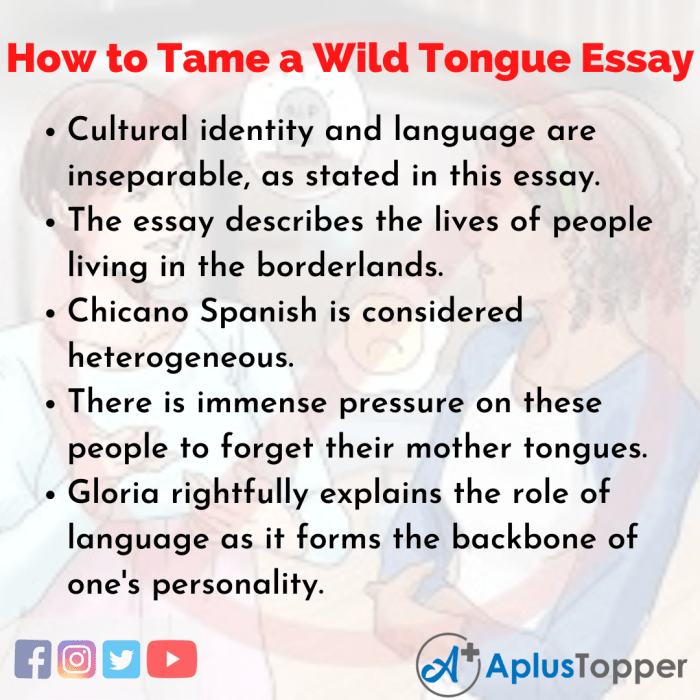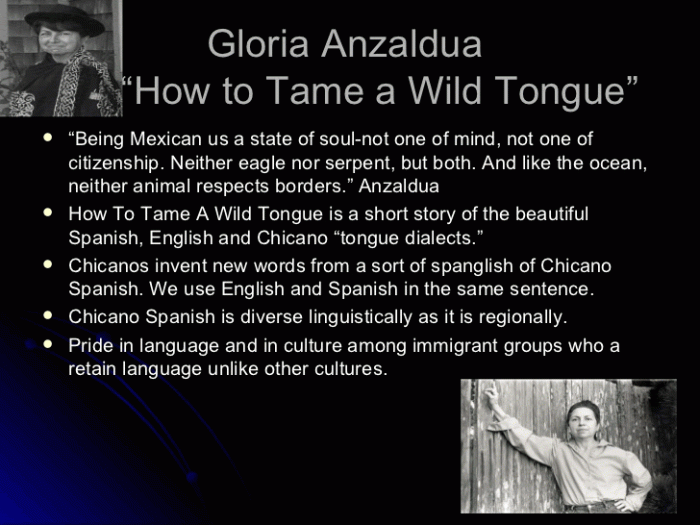How to tame a wild tongue quotes – In the captivating work “How to Tame a Wild Tongue,” author Gloria Anzaldúa offers a poignant exploration of language, identity, and empowerment through a collection of thought-provoking quotes. This introspective work delves into the experiences of Chicanas, examining the intricate relationship between language and cultural identity.
Anzaldúa’s powerful words resonate with readers, challenging traditional notions of language and power while illuminating the complexities of oppression and resistance. Through her skillful use of literary techniques, she weaves a tapestry of experiences that highlight the resilience and strength of Chicanas.
Historical and Cultural Context of “How to Tame a Wild Tongue”
Gloria Anzaldúa’s “How to Tame a Wild Tongue” is a seminal work in Chicana literature that explores the complex experiences of Chicanas in the United States. The book’s title itself holds deep significance, as it metaphorically represents the struggle of Chicanas to maintain their cultural identity while navigating the dominant Anglo-American culture.
Anzaldúa’s experiences as a Chicana woman growing up in Texas shaped the book’s themes. She witnessed firsthand the discrimination and oppression faced by Chicanas, and she became acutely aware of the ways in which language and culture were used to silence and marginalize them.
“How to Tame a Wild Tongue” is a powerful indictment of these oppressive forces and a celebration of the resilience and strength of Chicanas.
Historical and Cultural Factors
The experiences of Chicanas in the United States have been shaped by a number of historical and cultural factors, including:
- Colonization: The Spanish colonization of the Americas in the 16th century had a profound impact on the lives of indigenous peoples, including the ancestors of Chicanas. The Spanish imposed their language, culture, and religion on the indigenous population, and this process of colonization had a lasting effect on the development of Chicana identity.
- Immigration: In the 19th and 20th centuries, large numbers of Mexicans immigrated to the United States, seeking economic opportunities. Many of these immigrants settled in the southwestern United States, where they faced discrimination and segregation. The experiences of these immigrants shaped the lives of Chicanas, who often faced similar challenges as their parents and grandparents.
- Assimilation and Resistance: Chicanas have faced pressure to assimilate into Anglo-American culture, but many have resisted this pressure and maintained their own cultural identity. This process of assimilation and resistance has been a defining feature of the Chicana experience, and it has shaped the development of Chicana literature.
Themes of Language, Identity, and Empowerment

Gloria Anzaldúa’s “How to Tame a Wild Tongue” explores the complex relationship between language, identity, and empowerment for Chicana women. Anzaldúa argues that language is a powerful tool that can be used to shape and define one’s identity, and that by embracing their own unique language and culture, Chicana women can resist assimilation and oppression.
Role of Language in Shaping Chicana Identity and Experiences
Anzaldúa argues that language is central to the formation of Chicana identity. She writes, “The language you speak shapes the way you think, the way you perceive the world.” For Chicana women, who have historically been marginalized and silenced, language can be a source of both oppression and empowerment.
- On the one hand, the dominant language of English can be used to exclude and silence Chicana women. Anzaldúa writes about how she was punished for speaking Spanish in school, and how this made her feel ashamed of her native language.
- On the other hand, Chicana women can also use language as a tool for resistance. By reclaiming their own language and culture, they can challenge the dominant narratives that have been imposed on them.
Language as a Tool for Empowerment and Resistance, How to tame a wild tongue quotes
Anzaldúa argues that language can be a powerful tool for empowerment and resistance. She writes, “The ability to speak our own language is a matter of survival.” For Chicana women, who have historically been marginalized and silenced, language can be a way to reclaim their voices and to challenge the dominant narratives that have been imposed on them.
- Anzaldúa writes about how she uses her writing to explore her own identity and to connect with other Chicana women. She says, “I write to free myself from the silence that has been imposed on me.”
- Anzaldúa’s work has inspired other Chicana writers and activists to use their voices to speak out against oppression and to celebrate their own unique culture.
Challenging Traditional Notions of Language and Power
Anzaldúa’s work challenges traditional notions of language and power. She argues that there is no one “correct” way to speak, and that all languages are valid. She also argues that power is not something that is fixed and unchanging, but rather something that is constantly being negotiated and contested.
- Anzaldúa’s work has helped to break down the traditional hierarchy of languages, and to create a more inclusive and equitable understanding of language and power.
- Anzaldúa’s work has inspired other scholars and activists to challenge traditional notions of language and power, and to work towards creating a more just and equitable world.
Literary Techniques and Style

Gloria Anzaldúa employs a diverse range of literary techniques to convey her message in “How to Tame a Wild Tongue.”
Figurative Language
Anzaldúa uses figurative language extensively, including metaphors, similes, and personification. These techniques help her to create vivid images and make abstract concepts more concrete. For example, she describes the Spanish language as a “wild tongue” that “cannot be tamed” and compares it to a “broken butterfly.”
Imagery
Anzaldúa also uses imagery to create a strong sense of place and to evoke the emotions of her characters. Her descriptions of the borderlands, where she grew up, are particularly evocative. She writes about the “dry, cracked earth” and the “barbed wire fences” that divide the United States from Mexico.
Symbolism
Anzaldúa uses symbolism throughout the book to represent different aspects of her identity and experience. For example, the wild tongue represents her own voice and the struggle she has faced to find her own voice. The borderlands represent the physical and cultural barriers that she has had to overcome.
Writing Style
Anzaldúa’s writing style is characterized by its use of stream-of-consciousness and fragmentation. This style helps to create a sense of immediacy and to convey the complexity of her own thoughts and feelings. She also uses code-switching, which is the practice of switching between different languages or dialects, to reflect the multilingual nature of her own experience.Anzaldúa’s
use of literary techniques and style contributes to the overall impact of the work by creating a vivid and engaging reading experience. Her use of figurative language, imagery, and symbolism helps to make her message more concrete and memorable. Her writing style reflects the complexity of her own identity and experience, and it invites readers to reflect on their own identities and experiences.
Critical Reception and Impact

How to Tame a Wild Tonguewas met with critical acclaim upon its release in 1987. It was hailed as a groundbreaking work that gave voice to the experiences of Chicana women and challenged traditional notions of language and identity.
The book’s impact on Chicana literature and feminist scholarship has been profound. It has inspired a new generation of Chicana writers to explore their own experiences and identities, and it has helped to shape the way that scholars think about the role of language in the construction of identity.
Beyond academia, How to Tame a Wild Tonguehas also had a significant impact on contemporary conversations about language, identity, and empowerment. The book has been used in classrooms and community centers to teach about the importance of language and culture, and it has inspired countless individuals to embrace their own unique voices.
Themes of Oppression and Resistance
Chicanas in “How to Tame a Wild Tongue” face various forms of oppression, including:*
-*Linguistic oppression
Suppression of their native language, Spanish, and forced assimilation into English.
-
-*Cultural oppression
Marginalization of their cultural traditions, customs, and beliefs.
-*Racial oppression
Discrimination and prejudice based on their Mexican heritage.
-*Gender oppression
Patriarchal societal norms that limit their opportunities and autonomy.
The author resists these forms of oppression through various strategies:*
-*Language reclamation
Embracing and celebrating the Spanish language as a source of strength and identity.
-
-*Cultural preservation
Documenting and sharing Chicana cultural traditions to preserve their heritage.
-*Empowerment through storytelling
Sharing personal narratives to raise awareness about the experiences and struggles of Chicanas.
-*Community activism
Organizing and participating in collective action to challenge oppression and advocate for change.
Role of Community and Solidarity
Community and solidarity play a crucial role in overcoming oppression. The Chicana community provides support, strength, and a sense of belonging to its members. Through collective action and shared experiences, they build resilience and empower each other to resist oppression.
The Importance of Education and Literacy

Education and literacy play a pivotal role in empowering Chicanas by providing them with the knowledge, skills, and critical thinking abilities necessary to challenge societal norms, break down barriers, and advocate for their rights.
The author promotes education and literacy as tools for social change by highlighting the ways in which they can transform individual lives and contribute to collective empowerment. Through education, Chicanas can gain access to better employment opportunities, participate more fully in civic life, and become more effective advocates for their communities.
Challenges Faced by Chicanas in Accessing Education and Literacy
Chicanas have historically faced numerous challenges in accessing education and literacy, including:
- Poverty and economic inequality
- Discrimination and racism in educational institutions
- Lack of access to quality early childhood education
- Limited access to higher education
These challenges have contributed to lower literacy rates among Chicanas compared to other population groups, perpetuating a cycle of poverty and inequality.
The Power of Storytelling

Storytelling holds immense significance within Chicana culture, serving as a vital means of preserving and transmitting cultural heritage, experiences, and perspectives. For Chicanas, storytelling empowers them to reclaim their voices, challenge dominant narratives, and forge a sense of collective identity.
Therapeutic and Transformative Power
Through storytelling, Chicanas find solace and healing from the traumas and oppressions they have endured. By sharing their personal narratives, they create a space for validation, empathy, and catharsis. Storytelling also enables Chicanas to confront and process their experiences, leading to personal growth and empowerment.
Themes of Gender and Sexuality

Gloria Anzaldúa’s How to Tame a Wild Tongueexplores themes of gender and sexuality in a complex and multifaceted way. Anzaldúa writes from the perspective of a Chicana lesbian, and her work challenges traditional notions of gender and sexuality, particularly as they relate to the experiences of women of color.
One of the ways in which the book explores themes of gender is through its portrayal of the challenges faced by Chicanas in navigating gender and sexual norms. Anzaldúa writes about the ways in which Chicanas are often expected to conform to traditional gender roles, which can be limiting and oppressive.
She also writes about the ways in which Chicanas are often subjected to sexual violence and abuse.
The Author’s Portrayal of Female Empowerment and Sexuality
Anzaldúa’s portrayal of female empowerment and sexuality is complex and nuanced. She writes about the ways in which Chicanas can find strength and power in their own bodies and sexuality. She also writes about the ways in which Chicanas can use their voices to speak out against oppression and injustice.
Detailed FAQs: How To Tame A Wild Tongue Quotes
What is the significance of the title “How to Tame a Wild Tongue”?
The title alludes to the challenges faced by Chicanas in navigating the dominant culture’s expectations for language and behavior, while also highlighting the power of language as a tool for self-expression and empowerment.
How does Anzaldúa use language as a tool for empowerment?
Anzaldúa employs language that is raw, personal, and unapologetically Chicana. By embracing her own language and experiences, she challenges traditional notions of correctness and propriety, empowering readers to find their own voices.
What are some of the forms of oppression faced by Chicanas in the book?
The book explores various forms of oppression, including linguistic discrimination, racism, sexism, and homophobia. Anzaldúa highlights the intersectionality of these oppressions and their impact on the lives of Chicanas.